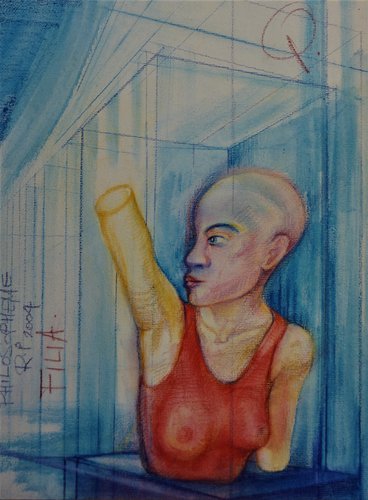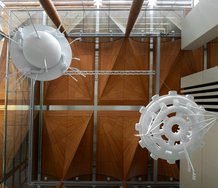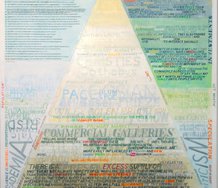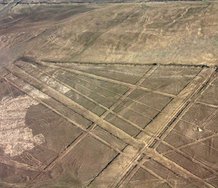Ralph Paine – 7 August, 2021
Her diary entry for the day records the fact that it did not rain; expresses doubts about how to follow through on K___'s mannerist advice; and ends with a question: definitions of war? Spending the following day in town trawling second-hand bookshops she purchases beat-up old copies of Clausewitz's 'On War', Clastres's 'Archaeology of Violence', Wittig's 'Les Guérillères', the Nazi Schmitt's 'Theory of the Partisan', and Cixous & Clément's 'The Newly Born Woman'.
EyeContact Essay #43
“When a child is born, the midwife lets out a war cry.”
—Monique Wittig, Les Guérillères
She conjures thoughts of war. A field of thought held between two poles of attraction: the Desert & the City. War is the field, the poles her desire. Everything goes rapidly this way, slowly that way. And vice versa. The Problem: how to glean from this field the notion ‘Coming Wars’? Seeking new conceptual weapons, she has retreated deep into the western suburbs, to her mountain of books and papers, anonymity, and forays to the mall. “What is it that has not-quite-yet appeared in the field yet nevertheless will have emerged in some way within its manifest concreteness?” A diagram? Diagrams are preparatory, they track tendencies, impulses, virtuality. Diagramming is noting, configuring, jotting, sketching; and simultaneously, crossing-out, removal, realignment. Coterminous with the field, between the City & the Desert lies the diagram. “What is my war diagram?”
She studies Deleuze & Guattari’s diagram. Intersocial and constantly evolving, it never functions to represent a persisting world but produces a new kind of reality: ‘diagramming constructs a real that is yet to come.’ When D&G describe a diagram as an “abstract machine” what they mean is that it functions as ‘an immanent cause’ i.e., a cause flush with the socio-technical assemblages that will execute its relations. Yet these relations—precisely because they are expressed diagrammatically—are ‘virtual, potential, unstable, vanishing and molecular,’ and thus constantly giving realization to assemblages and functions which integrate the diagram in new and ever-expanding ways. An ever-expanding and horrified fascination for Global State Capitalism (aka Empire) launches her war diagram: lines, notes, jottings, sketches, crossings-out, realignments for a potential counter-fascination.
“What is the current war space, the current field?” Syria, Iraqi, Afghanistan, Yemen, Palestine, across Africa, Central America, Azerbaijan/Armenia, Ukraine/Russia, Kashmir/Pakistan, Myanmar, Papua, and on and on it goes, border skirmishes, occupations, internal strife, economic sanctions, drone strikes. A geo-political hell-scape leaking fire and brimstone everywhere. Depleted uranium. Tear gas and torture. Crazy-quilt effect of militarized land, sea, and air: Military Inc. Concerning real estate cycles and what she names ‘the fortress-function,’ she does not restrict herself to employing centre-periphery figures of global connectivity and conflict. Today’s war space subsists in mixtures of North and South, palace, slum, and every contortion in between. The fortress is distributed throughout, unevenly but nevertheless throughout. Ditto the siege and the attack.
Her draft typology of (intermingled) zones of the field will include:
Favella-type security: barbed wire topped artisanal gates and iron fences, vicious guard dogs, graffitied roller-doored shop fronts, grilled windows, local gangs, para-military raids …
Wealthy suburban-type security: McMansion architecture, electric gates and strengthened garage doors, high tech alarm systems and in-house surveillance, privatized vigilantism, police car and helicopter patrols …
Warlord kitsch security: mirror-windowed mansions inside compounds, luxuriant screened gardens with swimming pools, grand and ornate reception rooms, elaborately designed defence walls, ramps, and bollards of reinforced concrete, flood lit razed spaces surrounding, heavily armed convoys moving compound to compound, neighbourhood intimidation … Glass-tower security of metropolitan centres: verticalized safety, scanners, cameras everywhere, helipads, privatized guards …
Bunker security …
But also, more diversified and omnipresent forms of the fortress-function e.g., cyber-security, bio-security, social-security, space-security, cultural security (group manias for recognition as synced with identity politics and facilitated by the big media platforms), existential security (the final frontier).
The production, distribution, and consumption of security. Business as usual, 24/7. Global State Capitalism = New World. “So there is no city/countryside division here.” Within Empire, plantations, farms, factories, towns, ports, roads, railway, air space etc., all form familiar networks and circuits. A circuit of circuits, endlessly increasing forms and flows of commodification. Logistics is a military term. “Yet what hyper-movement connects all this?” “What vortex, whirlwind?” $$$ “Private-public synergies of development and financialization.” And here she includes brief notes and crazy little flow charts mapping financialization’s myriad vectors and sub-manifestations, its infrastructural complexity: computer stacks, cables, mines, satellites and rockets, the car, van, truck etc., container ships, railways, motorways, port facilities, canals, SEZs, airports, road tolls and taxes, oil, gas, electricity … SPEED, Transports, projectiles, accidents, energetics … Paul Virillio: speed is ‘the negation of space, the gaining of time.’ An endocolonisation of time.
She’s struck by Virillio’s books, sensing there a very appealing apocalyptic tone, as if some heavy-shit reckoning is about to go down. Not that Virillio liked the idea of apocalypse, associating it with a revolutionary destruction of the world and its replacement with some bound-to-be-dangerous New Order, thus preferring instead the idea of revelation, a time of realignment when the world’s limits (‘finitude’ is the word she remembers him using) will become apparent to all and so a new situation will be revealed rather than any new order as such. “And in this new situation???” In any case, she’s on a roll with Virillio, thinking that if every society includes and embodies a war-function, no doubt today’s is embodied via the ubiquity and force of motors. Urban planning, regional planning, state planning, global planning—all feel to her like military strategy. Financialised military strategy. The debt-credit system is Empire’s ever-war on the future.
“Perhaps I’ve come all too late to this. Late in history, late to Empire’s ‘there ain’t no outside no more’ project … with the critiques already perfected, the counter models fine-tuned, a radical cartography drawn up … yet still this empty feeling of defeat.” “What’s there to say?” she asks K___. “Sure, yeah, end times stuff … but style-wise, I’m thinking that lateness relates well to mannerism,” replies K___ in more upbeat tone. “In art history, like, where those who came late, the mannerists, had to choose how to, umm, inherit—is that the right word?—yeah, inherit from the classic models and decide on what to do with them, how to distort them, pervert them even.”
Shaded by a big pohutukawa, they’re lying on the slope of a park in her old neighbourhood, idly talking diagram ideas as if some crit session, summer almost gone, a ramen lunch still full in their bellies, old friends. “Anyhows, with this whole diagram thing, seems as if you’re already on a mannerist track, umm, so with D&G as the classic model you’re gonna have to pervert the perverts, re-diagram the great diagram thinkers.” “You’re right K___, kinda all too much though … how on earth to re-spin the magic webs of these writers, you know, such grand mannerists?” “Umm, perhaps the only way is from within, like, become impersonal on it … as an artist, whatever, slip into their world, rummage around, select this ‘n’ that, but leave only barely perceived traces.” “Like a thief in the night?” “For sure,” K___ replies, smiling. “Honour among thieves.” “What did Jorge Luis Borges say?” “Hmmm, something like Modifying the past is the only basis of tradition.” “Cool, yeah, and sometimes with only the smallest difference … like the difference between twins.” A sudden breeze swirls in the park, dark clouds moving across the sun. She shivers. “I’m getting cold K___ … do think it’s gonna rain?” “I wish,” “but hey, yeah … let’s make tracks, I’ve gotta buy stuff for dinner.” They stood and hugged, thanking each other. “Keep me in the loop hun.” “Will do K___ … the fucking war loop.”
Her diary entry for the day records the fact that it did not rain; expresses doubts about how to follow through on K___’s mannerist advice; and ends with a question: definitions of war? Spending the following day in town trawling second-hand bookshops she purchases beat-up old copies of Clausewitz’s On War, Clastres’s Archaeology of Violence, Wittig’s Les Guérillères, the Nazi Schmitt’s Theory of the Partisan, and Cixous & Clément’s The Newly Born Woman. Outbound on the Western Line, unwrapping the packages, reading the blurbs and recommendations, she sinks into air-conditioned calm. Shutting her eyes against the harsh low sun outside she’s reminded again that there’s been no rain for months. Temperatures are way up, the city’s dams and reservoirs low, restrictions in place, gardens and parks suffering, totally parched. The desert grows. “Where’s that line from?” “Nietzsche perhaps? Metaphor for his affirmative version of nihilism?” Shades of accelerationist thought.
An anthropologist, Pierre Clastres suggests a delirium of the tribes, a ‘primitive’ form of war, an obsessive-compulsive warding-off of centralized power—of all centralized organs of power—by means of war. War is a way of destituting the very possibility of any state-formation arising within the tribe, or any related tribe. This feels important to her vis a vis the current ‘ontological turn,’ the rapidly increasing emergence of indigenous struggles against pipelines, mining, forestry, etc. “It’s as if this current tribal delirium is a war on war, a war against the extractive violence of states.”
Clausewitz is a state thinker. His initial definition of war is like what she had thought. He speaks of duels: ‘War therefore is an act of violence intended to compel our opponent to fulfil our will.’ Will to power. And always accompanied by the force of economic reason: Clausewitz mentions the requirement of a nation state for upholding war’s ‘moral force.’ “Yeah, Westphalia and all that.” His famous passage: ‘Is not war merely another kind of writing and language for political thoughts?’ In times of politicized peace, policed peace (a fully legitimate carceral-industrial complex), the enemy becomes those whom we defend ourselves against and counterattack within the Desert-City circuits: Planetary Civil War. Shades of Tiqqun. We too are the enemy … she scribbles in her notes … The enemy of Empire. We form dangerous alliances. We are a community affected by each other’s revolutionary vibe. We are everything that might happen, everything that might disrupt Empire’s norms and apparatuses. Our risk to Empire is omnipresent.
She juxtaposes brief thoughts on, first, ‘force of law’ (Derrida), monopoly state violence, coercion, exploitation, colonization (‘primitive accumulation’: Marx, Capital, Vol. 1); and second, comradeship, co-operative logics, hospitality, commoning à la Negri, Federici, et al. “But how to include here theories positing a multi-species entanglement that some theorists name the ‘latent commons,’ an entanglement not necessarily conducive to human flourishing?” Her juxtaposition is left incomplete, fragmentary, nevertheless leading to a rough enough take on the differences between political powers-that-be and powers-as-potentials, the latter perhaps not even regarded as ‘political.’ A rough enough take. More of a dynamic than a dialectic. She wonders about Hegel’s master/slave thing, and all those variations on the theme, from Kojève to Fanon to Angela Davis, always from the situated perspective of the slave. War as counter-violence against a master; an emancipatory struggle to the death.
In A Thousand Plateaus Deleuze and Guattari say it something like this: historically, the states appropriated the nomad war machine’s potentiality—i.e. freedom qua the creation and moving occupation of liberatory smooth spaces and their continual enlargement—thus giving the machine constituted economical-political aims, subordinating its potentiality to actualized war as its now sole objective (‘its direct object’ they say): the enforced proliferation of ever renewed friend/enemy distinctions, continental wars, nuclear stockpiles, local wars, special force operations, psyops, police-military synergies, etc., resulting today in the terrifying ‘peace’ of a planetary war machine: total war = total peace = unlimited war against an unspecified enemy, war on drugs, war on terror = widely diffused ecologies of poverty and fear = displacement and migration. Under these conditions, the capitalist war machine begins to operate quasi-autonomously, gaining a highly corporatized independence from and dominance over all nation states: Empire.
Meanwhile, everywhere there arose a remarkable resistance, an insurgency of shape-shifting war machines directed against the Global State Capitalist axiomatic and its ensuing catastrophe: minority war machines (always in sync with the famous dictum: ‘the people are missing’), art war machines (Rammellzee, ACT UP), writing war machines (‘adorable little organo-tachikomas hell bent on throwing tiny clogs and spanners into the works of every microelectronic assemblage currently engaged in the mass neuro-torture of humankind. Thank you little allies’), sonic war machines (‘low frequency vibration as a technique of affective mobilisation’), eco war machines (Standing Rock), etc. Yet given the current exhaustion, ruin, defeat, and trauma in extremis, the possibility of some potent continuation of this creative resistance seems to her as if already in tatters, already captured by Empire, enslaved. No future but the eternal present. “How might the coming war machines source fresh provisions, matériel?” “What supply chains will be required?” “How to repopulate the world with newly mutant forms of free-action?” Time to switch off, to eat. She flicks on Grime’s Miss Anthropocene, swirling bass & bliss. Chanting in tongues. Songs for the lost children of Empire. Fried rice and a couple of Sapporos.
Her late afternoon double-shot expresso was a mistake. Waking the next day before dawn, weirded-out after restless sleep, memories of a bad dream on repeat all bedevilled by malevolent ex-lovers and an ever-circling pack of wild dogs, the same fragmented scenarios reiterated to anguished background futility, she dresses quickly in the chill air and heads on down the creek path, across the footbridge and up onto the fields beyond, a quickening pace clearing her head, the sun rising over a treeline to the east, orange glow, toxic smudge, and to the north a constant roar from the motorway gaining decibels as the City-Desert complex stirs itself awake. Big Oil, a dominance over and subversion of the nation states by corporatism and its anti-environmentalist propaganda machine. “They’ve known about climate change since the mid-60s.”
Already she had noted D&G’s uses of Virillio’s Speed and Politics, but now wants to emphasise their critique. Yes, war involves extreme speeds, but also extreme slowness, interminable sieges as much as it does rapid attacks. The knight is a mixture of both catatonia (the half-sleep of endless weeks in the saddle, the journey-as-stillness) and speed (the headlong charge and frenzy of the battle). She goes searching in her books for philosophical analyses of slowness. “In Nietzsche, perhaps … His slow walks?” “Yet these, it seems, always in counterpoint with his quick dance, his aphoristic, fragmented style. Thought-shrapnel.” After that it’s all blank. She queries K___ on WhatsApp and within a few minutes receives this: ‘Try Walter Benjamin, the title of Susan Sontag’s essay about him says it all: Under the Sign of Saturn.’ She looks up Benjamin’s exact words—‘I came into the world under the sign of Saturn, the star of the slowest revolution, the planet of detours and delays‘—then replies to K___, thanking her: ‘Yes! against the day I’m gonna have to put the old word melancholia back into use.’
Meanwhile, a discoloured and foxed-up old copy of Robert Burton’s The Anatomy of Melancholy offers up further affirmation: ‘In this Labyrinth of accidental causes, the farther I wander, the more intricate I find the passage, multae ambages …’ “Multae ambages? Many windings perhaps.” The melancholic will see the City-Desert complex as a thing-emblem: potential labyrinth, refuge, solace, enchantment. Allegory at slow speed. Allegory at a complete standstill. A freeze-framing of events, a moment or situation allowing for—or better, impelling—the exploration of capacities normally hidden, covered over by the illusory effects of rapid speed.
Researching Benjamin, to her amazement she discovers that contra Marx he likens such a collective standstill to revolution: ‘Marx says that revolutions are the locomotive of world history. But perhaps it is quite otherwise. Perhaps revolutions are an attempt by the passengers on the train—namely, the human race—to activate the emergency brake.’ But … she notes down as a caution … ultimately speed is a qualitative phenomenon, a variable intensity, contrasted with movement as an extensive phenomenon, qualitative. Rapidly slowing something to a complete standstill is named Terminus Speed.
Weeks later, in a single sitting, angled winter light moving slowly across the room right to left, she reads Don DeLillo’s Point Omega. Minimalist and metaphysical, a haunting meditation on time, film, autism, war … the Desert, the City … from which she copied two passages:
It’s all embedded, the hours and minutes, words and numbers everywhere,” he said, “train stations, bus routes, taxi meters, surveillance cameras. It’s all about time, dimwit time, inferior time, people checking watches and other devices, other reminders. This is time draining out of our lives. Cities were built to measure time, to remove time from nature. There’s an endless counting down,” he said. “When you strip away all the surfaces, when you see into it, what’s left is terror.
Time falling away. That’s what I feel here,” he said. “Time becoming slowly older. Enormously old. Not day by day. This is deep time, epochal time. Our lives receding into the long past. That’s what’s out there. The Pleistocene desert, the rule of extinction.
She adds the terms ‘terror’ and ‘extinction’ to those of ‘melancholia’ and ‘catatonia.’ Not exactly opposites, but not synonyms either, and thus a strange zone of indiscernibility begins to emerge, swirling and rising around all four terms. “The fog of war writing.” She’s tired. Her period’s coming. Twitter, Insta, the news feeds, Google Search, Wikipedia are driving her demented. Ambivalence, uncertainty about direction and manner, her diagram lies in an a-cosmic haze.
She prefers not to. Smoking weed no longer inspires. For three obliterating days and nights sandstorms rage in her Desert-thought. She paces the house, curls up in bed, stares out windows. The City writhes like a snake in her brain, vast desolate spaces, exteriors and interiors, coiling-uncoiling in rapid black-on-black succession. Exhausted, blank, a stranger to the very project that she herself has formulated, she abandons it all to the Cloud and the map drawers. Breathing out, breathing in … Breathing out, breathing in. Calmly, slowly she welcomes back in esoteric techniques of neutrality and contemplation. A last note: Theoria = Awareness. The old meaning.
Rites of passage to the Ineffable compose an idyllic spring. Housekeeping as therapeutic magic, morning tai chi, ignoring her books and papers, locking away the smart phone and laptop, ragas drifting through the house. “Summer … Summer’s almost here.” She walks a lot, goes sailing with her neighbour, his 30-footer taking them out to little bays on little islands in the gulf then back down the harbour channel at dusk, tacking or jibing depending on the course, her war-thoughts all swept away by the wind and tides, the rigging and the tiller. Ad hoc arrangements, when admixture becomes sorcery, ocean’s abandonment, of air rights and laziness, becalmed, learning crown knots and back splices, spreading charts beneath vast hallucinated skies, unpacking apples, tomatoes, baguettes & potato salad, tinned tuna & merlot, fluttering heart, perfect curve of the headsail, like the arc of her dives overboard, her reappearances up over the stern, hair dripping, naked, sun dazed ‘n’ stoned, blooming, budding, aimless.
A shock to thought, coming home down the motorway one night they drive by a crash site as if in extreme slow motion. Three wrecked and crumpled cars, strewn glass, ambulances and paramedics, flashing lights, a fire engine, firefighters, police sirens, and all at once the horrific intimacy of the scene brings back war-thoughts. “Oh my god someone’s died there,” she gasps. No reply, he stares ahead, keeps driving. She turns and gazes out the side window, silence engulfing the cab of the old Toyota Hilux amid whiffs of the motor, a silence so unknown and so compressed as to bring on tears. Soft tears. Tears of ecstasy, a strange turn on. What’s happening? Oh. She shifts in the seat and squirms her legs tightly together. Oh …
We didn’t know death was there when all along it was. Death was disregarded. Overlooked in favour of real things, of which death was simply just another. But death has suddenly shown the world of real things, the world of Capital, to be a lie. It is not the loss of an anonymous member of the world of real things that has affected me so deeply. What has affected me is that the world of real things has lost its supreme truth. The intimate life, which despite the summer, despite my wonderful new friend, had lost the ability to reach me. The intimate life, which I regarded as a thing, is now restored to me through a sudden absence. Death has revealed life in its absolute overabundance. Death has dissolved Empire’s real order. They arrive outside his house. Crickets chirping, a windscreen-view across the gully, new moon hanging over a distant hill. He turns to face her. “You OK babe?” “Yeah, good, I’m good,” she replies, “like, kinda odd, but just been thinking that, umm … that we ourselves are war … and, and I found the idea kind of exciting.” She pauses, no more certain about her words than he seems to be. “Can I stay?” she half whispers.
Trying to forget, but she misses him. Autumn’s come and he’s gone up north for a few months. “Work,” he said and she didn’t ask further. Harvest time. Keeping an eye on his place, feeding the half-feral cat, sometimes going down to the yacht to check the mooring, her days feel like tiny ruptures, as if Benjamin’s Saturn rules her heart. She restarts the sketching and writing machine. Would the intensification and contagious spread of a certain form of war-like slowness be enough to induce a radical break from Empire? What mutation of the swarm-brain might bring this about? What pandemic? A general refusal by the planetary ones (Spinoza’s multitudo) to regenerate along self-same lines. An adhesion to non-identity. “Sure, but what are the affective conditions for such a non-regeneration? And how might desires currently attached to escaping one’s capitalist identity become the non-coercive ground for this?”
In somewhat unfamiliar vibe, wondering where this thesis is even coming from, typing at rapid speed: being figured-forth by something/someone else through what one has in common with that something/someone else is named ‘expediency,’ a notion that I conceive as sure to play a pivotal role in any coming rupture/rapture. And this in at least three ways: first, it will require the forming of a community—a conduct of conducts—operational between active elements/forces, these organizing their commonality according to varying degrees of differentiation, heterogeneity, fabulation, threshold registration & adjustment, gradients of desire (the current slope of things); second, expediency is the object of the deployment of a parallel mode of activity named war-epistemology, an experiential, problem-based knowledge that will aim at ensuring adequate working affinities among local vortexes, flows, subliminal properties, contrasts, melds, geo-dynamics, and climates in play between multiple and variable field observations (approaches to chaos) and their feedback loops; and third, it is precisely on the basis of such a war-epistemology that I believe the ‘coming community’ will construct its most salutary decorum for the creation of a New Earth. She pauses. “The common alone cannot gather us … We ourselves are war.”
A mesh of simulated alternative scenarios runs in her half-wired brain, perverse counter-operational images of Empire screened at the infinite speed of thought … She invokes Desert melancholia and its law of extinction alongside the terror and catatonia of the City as today’s training grounds. Scorched earth as launching pad. Trauma as practico-heretical pedagogy for a transmuted esprit de corps. Learning how to draw meandering lines of creation out of speeding lines of annihilation. Lifelines. Love lines burst open far and wide (the becoming-woman of the warrior). “Yet no safe passage this, for love is the most dangerous passage of all, simply because it destroys the capitalist self.” Entanglement and (con-)fusion of the world, a multi-scalar commune of eccentrically moving bodies and intellect connected only by the motionless force of expediency.
“No doubt, both tactically and strategically, this will be an asymmetrical combat … Except, that is, at the times of our choosing.” A Chinese vibe; reminds her of Mao’s ‘long war’ against the Nationalists and the Japanese. In time, given time, time out of measured time, the war machines of our making will have arrived from Empire’s enfolded other side, a rainbowed Desert-City to come. To come and yet intimate to the Earth’s ungrounded now. Pan-Zoom. She seeks camouflage. Insignias & mottos. Secret names, sayings, & forces. Deep subterranean fissures, the most intricate of devices, torn and frayed clothing, battered jewellery, songs & tales of the fanciful, tracery, modes of escaping, in flight from every political economy of signs. Tinkering and bricolage unchained toward a making do with whatever’s at hand. New uses for old junk. Raiding the metaphysical graveyard. Tattooed happenstance of great care and skill. Grafted skin and fixed bones. War wounds slowly healing to fluorescent love scars. Ecstasy. And a final flourish, as if an impersonal signature marked on the undercarriage of her diagram/machine, a piercingly beautiful passage from Cixous & Clément:
A desire, like the one that can unleash a woman, that goes all the way and does not let itself be subjugated by anything. That imposes its necessity-as-contingency as a value without letting itself be intimidated by cultural blackmail, the sacrosanction of social structures. That does not organize life around the threat of death; because a life that has given up can no longer call itself life.
Hence, a path of intransigence and of passion. A place of lucidity where no one takes what is a pretence of existence for life itself. Desire is clearly there like a stroke of fire, it shoots the night through with something. Lightning! That way! I don’t have it wrong. Life is right here. Afterward, it’s death.
“Old anarchist method,” says her neighbour from out of the wind. “Living as if the revolution has already happened.” “Yes!” she replies, thinking without saying it that this yacht is my already happened revolution, something unfamiliar, astonishing, yet right fuckin’ here on this wild winter’s afternoon. Tacking down the channel into a brisk south-westly, trimmed sails, whitecaps and crazy elation, they’re heading home after twice round the harbour circuit. She checks the mark ahead, glances up the mainsail, pulls the tiller a little toward her left knee while meeting his eyes with hers: “Everything appears fragile, beautiful, and worthy of care,” she half shouts above the swirling sound. “I smile at the sight of all this fragility. Mine, yours, all of it … because beneath it I feel a savage spirit, something invisible, almost unsayable, something that survives every destruction.”
Ralph Paine

 Two Rooms presents a program of residencies and projects
Two Rooms presents a program of residencies and projects Advertising in this column
Advertising in this column



This Discussion has 0 comments.
Comment
Participate
Register to Participate.
Sign in
Sign in to an existing account.